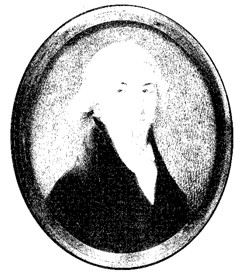Robert Scott (1800-1808)
 Robert Scott would appear to be an isolated figure in Irish botanical history, dogged by ill health and at odds with his fellow naturalists either through clash of personality or politics. His lasting contribution would be the establishment of a new botanic garden at Ballsbridge in 1806 replacing the then abandoned College Physic garden. The botanic gardens at Ballsbridge were to remain there until 1967 with the final transfer of plants to a newly established site at Trinity Hall in Dartry. Robert Scott’s other important contribution would be the appointment of one of the most influential botanists in Ireland as curator of the botanic gardens, James Townsend Mackay, later to be author of the first modern flora of Ireland, Flora Hibernica, published in Dublin in 1836.
Robert Scott would appear to be an isolated figure in Irish botanical history, dogged by ill health and at odds with his fellow naturalists either through clash of personality or politics. His lasting contribution would be the establishment of a new botanic garden at Ballsbridge in 1806 replacing the then abandoned College Physic garden. The botanic gardens at Ballsbridge were to remain there until 1967 with the final transfer of plants to a newly established site at Trinity Hall in Dartry. Robert Scott’s other important contribution would be the appointment of one of the most influential botanists in Ireland as curator of the botanic gardens, James Townsend Mackay, later to be author of the first modern flora of Ireland, Flora Hibernica, published in Dublin in 1836.
Robert Scott was born in 1757, son to Dr William Scott, a practising physician in Enniskillen, and Anne Scott (née Crawford) who was adamant that her son would never enter Trinity College but enrol instead to study medicine at the University of Edinburgh. It was after graduating from Edinburgh that Scott took up employment as a physician and licensed practitioner in midwifery in Dublin.
Although there is very little information available of Scott’s life, and that which is known described in full detail by Nelson (1998), it would seem from existing correspondence with notable naturalists then such as Robert Brown and Dawson Turner, that Scott was a keen and respected field botanist in Dublin before his appointment as Professor of Botany at Trinity College in 1800. With respect to his academic qualifications it was a requirement for the position of Professor of Botany that the candidate should have a degree in medicine. Indeed, at the end of the 18th century Professors of Botany at Trinity College had all to be members of the Faculty of Medicine. One of Scott’s first duties on appointment was to recruit a gardener at a salary ‘not exceeding 50 guineas a year’ which in modern terms would be equivalent to an annual salary of....In addition Scott was allowed the sum of 100 pounds to procure plants necessary for the teaching of Botany. Continuing this monetary theme, it may also be inferred that Scott was considered a worthy lecturer. Fees for attendance at botanical lectures before his appointment were fifteen shillings, but increased after his appointment in reflection of his skills to twenty five shillings. There is also information cited by Nelson (1998) into student contact hours expected of the Professor of Botany. Records exist stating that Professor Scott should provide for students 4 lectures a week for thirteen weeks from April to July.
Scott’s name in Irish botanical publications first appears in 1804, four years after his appointment, with a book on native Irish mosses being dedicated to him by its author, Dawson Turner (Muscologiae Hibernicae Spicilegium). The genus of Australian Fabaceae, Scottia, is also named after him. With regard to his own work then Scott described at least three newly described species of plants in Ireland, Utricularia intermedia first recorded in Fermanagh, Dicranum scottianum first recorded in Cavan and Grimmia maritima first recorded in Balbriggan besides contributing at least 51 records to James Townsend Mackay’s ‘A Systematic Catalogue of Rare Plants Found in Ireland ’.It is his appointment of Mackey as curator of the new Botanic Gardens however that is Robert Scott’s lasting legacy.
Source:
Information abridged from Nelson, E.C. (1998) ‘A willing Cicerone’: Professor Robert Scott (ca. 1757 – 1808) of Trinity College, Dublin, Fermanagh’s first botanist, Glasra, 3, 115-143.